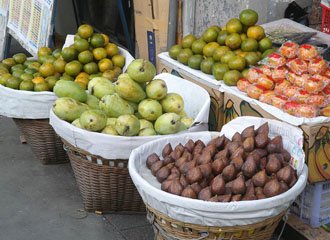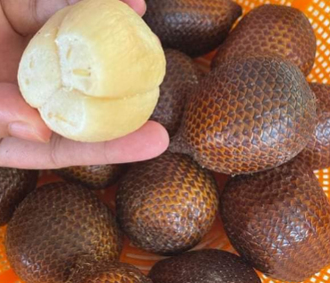Table of Contents
How to choose
 |
| Snake fruits in a market. Photo courtesy: Seika. |
The snake fruit season can vary slightly depending on the region. Fresh fruit available as early as May till September.
Look for snake fruit that has a deep reddish-brown to reddish-black skin. The skin should be firm and free from blemishes or mold. Choose fruits that are of a uniform size and shape, as this can be an indicator of quality.
Avoid those with green or yellow patches, as they may not be fully ripe. Also, stay away from overly soft or mushy, as they may be overripe and fruit with damaged or flaking scales, as this can indicate poor quality.
Storage
Snake fruit can be stored at room temperature for a few days if you plan to consume them relatively quickly. However, they are best enjoyed when fresh, so try to consume them within a day or two.
For extended shelf life, you can refrigerate them. Place them in a perforated plastic bag to allow for air circulation to prevent mold growth. Do not freeze, as it can alter the texture and flavor of the fruit.
Food use
Snake fruits are eaten in the same way as lychee and lanzones. To prepare, just wash the fruit in cold water and mop dry using a clean towel. Peel the outer cover by splitting it near the cone end and then working downwards. Pit and enjoy cream colored, crunchy aril.
Just like other soapberry family fruits like lychee, ripe longans are generally eaten raw out of hand. Enjoy their sweet and musky arils and spit out seeds.
Here are some serving tips:
-
Snake fruit It is a popular fruit in Southeast Asia and is gaining recognition in other parts of the world due to its distinctive flavor and appearance.
-
This fruit can be freshly eaten to enjoy its distinctive taste and flavor.
-
It is processed into products such as pickles, candies, fruit salad, fruit juice in Indonesia, Philippines, and Malysia.
-
Value added products of snake fruit very much enjoyed include smoothies, pies, and ice creams.
-
The kernel of “Pondoh” variety can be eaten.
Safety profile
Snake fruit is a delicious and nutritious tropical fruit that many people enjoy. Allergic reactions are rare.
Do not eat unripe, raw snake fruits as they contain astringent compounds like tannins, which may burn the oral cavity, tongue, palates, and throat. Discard longans seeds.
Pregnant women can enjoy salak in limited quantities; avoid chewing the seeds.
Also read ≻≻-
≻≻-Lanzone (Langsat) fruit nutrition facts and health benefits.
≻≻-Rambutan nutrition facts and health benefits.
≻≻-Lychee (litchi) nutrition facts and health benefits.
≻≻-Back to Fruits category from Snake fruit. Visit here for an impressive list of all variety of fruits with
complete illustrations of their nutrition facts and health benefits.
≻≻-Back to Home page.
Further References:
-
Salacca zalacca – (Gaertn.) Voss.-Plants for a future. (opens new window)





More Stories
Avocado Cacao Mousse – JSHealth
Janelle Brown on Garrison’s Mental Health Before His Death
How To Finally Beat Insomnia